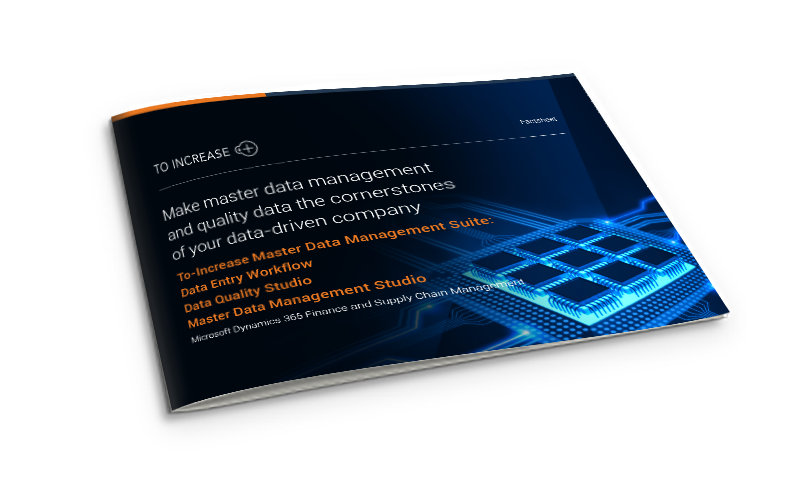Successful data governance is a collaborative effort across many roles within an organization. Policy and rules set by a cross-functional team supported by tools is the recipe for success! Many organizations make the mistake of handing over all the responsibilities of data governance to the IT team. The IT Team needs to be involved but they simply cannot manage the task of Data Governance without the insight of data owners from other business functions and data managers that specialize in working with different types of data sets.
To get buy in from the entire organization it is important to assign roles and responsibilities prior to working on the processes.
At To-Increase, we have helped several customers across each stage of their data lifecycle using our Data Governance and Business Intelligence solutions designed for the Microsoft Dynamics 365 ERP. Our solutions can help you improve data quality, simplify data entry, and master data management, integrate applications and synchronize data, and also derive value from their improved master data using analytics.
We’ve heard many of our customers struggle with how to implement an MDM strategy, so we have put this blog together, with a comprehensive list of roles to help you achieve success. So, go ahead and bookmark this blog!
The data governance organization
The data governance organization as we would like to call it, is made up of people at different levels, making a larger team with different and specific responsibilities. They work together to create a data pyramid. Let’s look at what each of these are in detail below:
The Operational Level
This is specific to each business unit and consists of Data Stewards who could be either managers or individual contributors. They play a very important role in framing the data governance strategy since they produce and use the data, and create the definitions of data for their business unit. The data that they record, will be passed on to teams to better understand what processes need to be implemented or changed.
Below are the responsibilities of the Operational Data Stewards:
- Responsible for data across the various life stages of data from creating to archiving and deleting the data.
- Defining guidelines for data for their respective business functions. This will include guidelines of data use, security, and data management.
- Creating data definitions for their business function.
- Overseeing the quality of any data created in their business function.
- Understanding and defining access for data viewing, editing, and deletion within the team.
- Training team members regarding the data definitions, processes, quality checks, and other important updates based on the existing or updated data governance strategy.
- Tracking and sharing possible issues regarding data that might arise with the concerned teams.
The Tactical Level:
The tactical level consists of Data Domain Stewards (DDS) and Data Steward Coordinators (DSC) and these are ideally people from cross-functional business units. The DDS are Managers of specific subject areas, and DSC are Managers of specific business units.
Organizations often find it difficult to fill up this level as these are people from various teams coming together and sharing data received from the Data Stewards from the operation level. It is crucial to identify the right people for these roles so that decision-making is unbiased and strategic. In certain cases, organizations decide that no decisions are made at the tactical level but at the strategic level. The DSC usually do not have the authority to make decisions and their role is more focused on coordination, reporting, documentation, and training.
Below are the responsibilities of the Data Domain Stewards:
- The DDS are responsible for data for a particular domain. Although the data steward might belong to a business unit, his/her responsibility as a DDS has to focus on the quality of the data presented by their business unit in relation to the organization in its entirety and all other business functions.
- The DDS is an important member of the cross-business unit team that acts as a mediator for defining data, and any challenges for data production, access, and usage.
- The DDS mediates between the strategic level and tactical level to raise issues and concerns.
- The DDS will define and document rules for data in their domain and ensure this is communicated forward.
- They will be responsible for regularly holding meetings with the Data Steward Coordinators and the operational team to discuss and document challenges related to business units.
Below are the responsibilities of the Data Steward Coordinators:
- As the name goes, the Data Steward Coordinators act as messengers and coordinate between the tactical level and operational level. They are responsible for communicating rules and regulations as per the data domain to the Data Stewards per business unit.
- They liaise between the operational stewards and data domain stewards to record and document challenges and resolutions.
- They need to identify people who could take on the data steward role at the operational level for the business unit.
- They need to have a clear understanding of the data at every stage for their business unit.
The Strategic Level
At the top level sits the Data Governance Council. The team consists of people from the senior management of each business unit and members of the IT team.
The operational Data Stewards pass on their observations and challenges to the Data Steward Coordinators. The Data Domain Stewards and Data Steward Coordinators analyze the information available at the enterprise level and this is presented to the strategic level where important decisions can be made. This level is important as decisions are made that are applicable to the organization for business processes or a data domain.
The escalation matrix also works in the same manner. Any data issues or challenges can get escalated to the strategic level if the decision-making authority lies solely at this level for the organization. Sometimes in a rare case, escalations can reach an executive level. Therefore, any information needs to be cascaded down from the strategic level after decisions are made, processes are changed, or resolutions are defined.
Below are the responsibilities of the Data Governance Council:
- They are responsible to finalize everything from data governance framework to tools, so they need to have a clear understanding of what data governance is.
- Identify people for data governance roles at the Tactical Level.
- Since decision-making usually happens at this level, the Council needs to set timelines for phased-out goals and implementation of processes.
- They need to cascade data governance practices in their areas of expertise and ensure these are followed.
- Set up regular meetings to assess the current data governance framework and the implemented tools and policies and set a roadmap for the way forward.
The Executive Level
At the top-most level of this data pyramid is the executive level with the Steering Committee that sponsors and approves the data governance strategy. The people in the committee need to be knowledgeable about the program, and the organizational structure and are usually from the top management of the organization. If this committee does not exist, then the team members have to be identified by the Data Governance Council. As part of this level, there is a Chief Data Officer who would lead the program, be responsible for funding, and hiring team members wherever necessary.
Below are the responsibilities of the Steering Committee:
- They need to ensure the team at the strategic level is equipped to play their roles as the Data Governance Council.
- They set a clear expectation of the goals that need to be achieved with data governance.
- Finalize and oversee initiatives across data domains and business functions.
The team in parallel across the data pyramid
This team consists of the Data Governance Chair and the Data Governance Partners and each of their roles differ, but they work with all the three levels across the organization – operational, tactical, and strategic.
The Data Governance Chair administer and oversee the data governance program, and their role is similar to an operations function in an organization. They coordinate and ensure the Data Governance Council are cascading communications and they coordinate with the other levels to ensure smooth functioning of the program, reporting on processes and challenges, if any.
The Data Governance Partners on the other hand are responsible for regulation and compliance. The team consists of IT members that are knowledgeable in data and system architecture, security, and other data domains. This team can include data specialists such as data quality analysts and data architects.
Below are the responsibilities of the Data Governance Chair:
- They are responsible for designing the architecture of the enterprise’s data governance framework.
- Outlining, reviewing, and assessing the data governance policies, standards, definitions, and procedures of the data governance framework based on the inputs shared by all the three levels in the data pyramid and the metrics tracked.
- Attending and providing inputs for the data governance council meetings.
- Offer guidance at every step of the data pyramid to the organizational, tactical, and strategic levels.
- Share documentation related to the data governance program at every step.
- Monitor and report results of the implemented data governance strategies to the Data Governance Council and executive leadership.
- Responsible for setting metrics that can be used for reporting.
Below are the responsibilities of the Data Governance Partners
- Responsible to set up data classifications for the various types of data, such as meta data, reference data, classified data, and so on. The data needs to be labelled and access levels need to be defined.
- To ensure compliance across the organization, they need to train people across the data governance team and share best practices for data quality and security with the larger data governance team.
- Adding security perimeters for IT infrastructure for all business units of the organization.
- Adding regulations to secure data and monitoring data access to ensure networks and data sharing internally and externally is secure.
- Assisting for any technical issues, implementation, data quality, data cleansing, and reporting.
Are you ready to work on a data governance framework?
Data governance is a continuous practice, so, you need to plan, and add roles and responsibilities while working on processes and prior to implementing tools. Additionally, you need to be flexible so that you can adapt and make changes as you go.
It may so happen that you might need to involve a different type of data owner that you had missed 6 months after implementing your data governance strategy, so it is best to keep an open mind and explain this to your stakeholders in advance. We recommend reading about the best practices in your industry to help you get started.
Once you have the right team members in place, it is easier to work towards the processes and policies. However, it is also important to analyze your current business infrastructure, the business processes, and the data flow between those. This will be an indicator of the tools you will need to execute your data governance plan.
For example, if you do not have an application integration software such as Connectivity Studio, integrating the data between your business processes and ERP, you could have data silos and data duplication. And if you are struggling with data entry, maintaining data quality, and master data distribution, you can consider our MDM Suite. To get started, download our factsheet from the link below to learn more about our data governance solutions and understand whether they would be a good fit for your organization or not.





